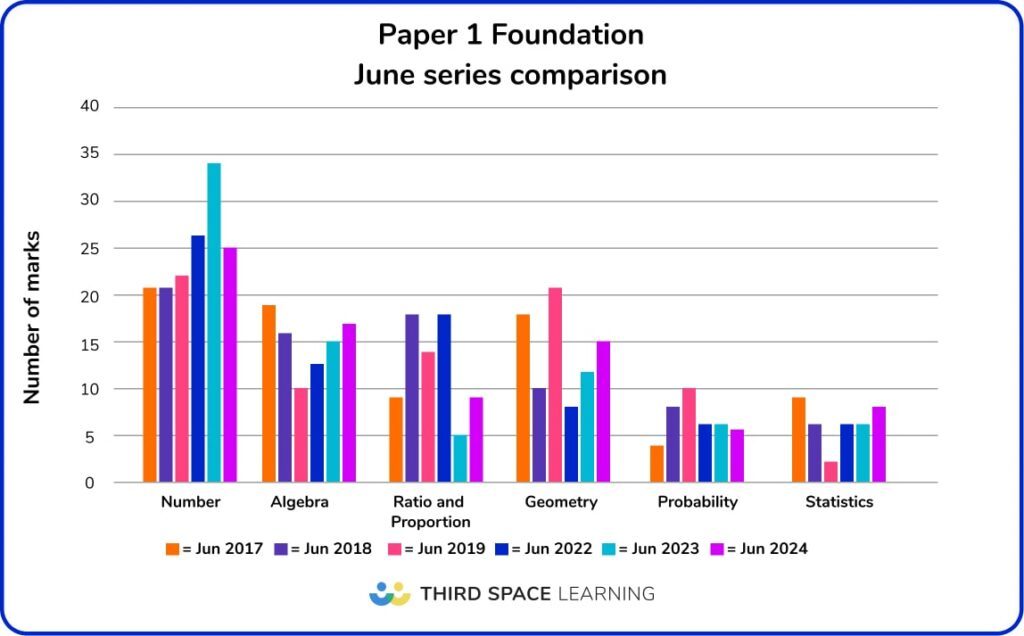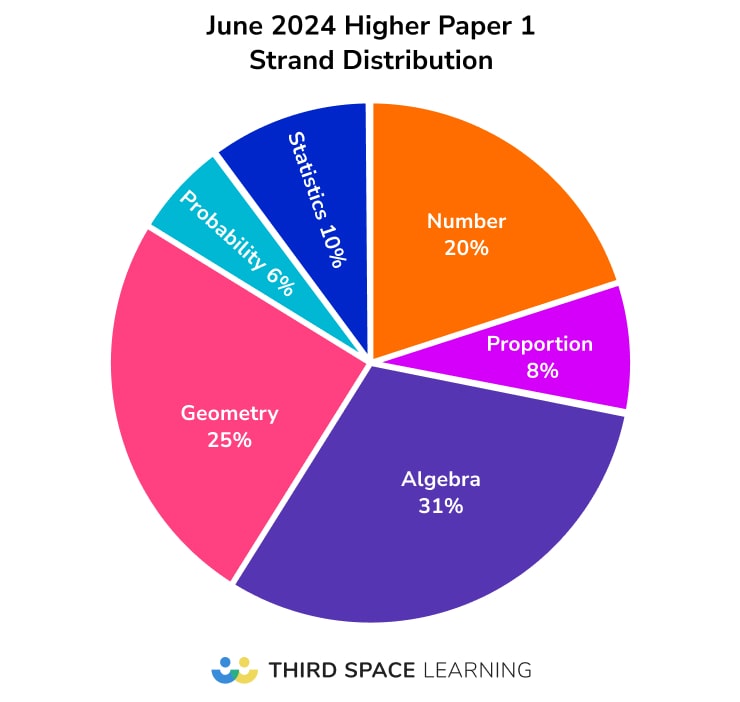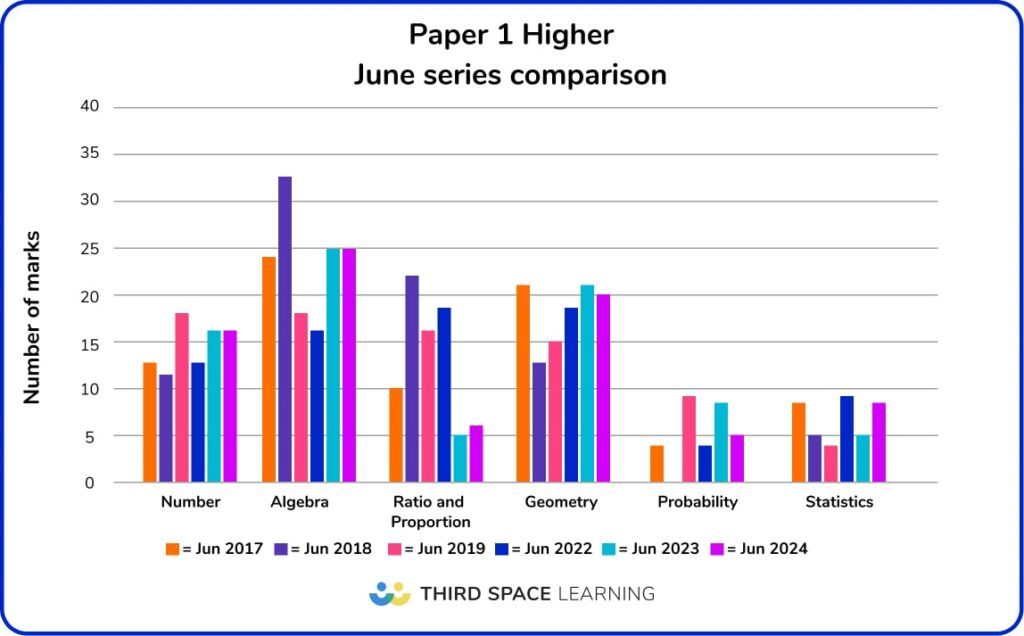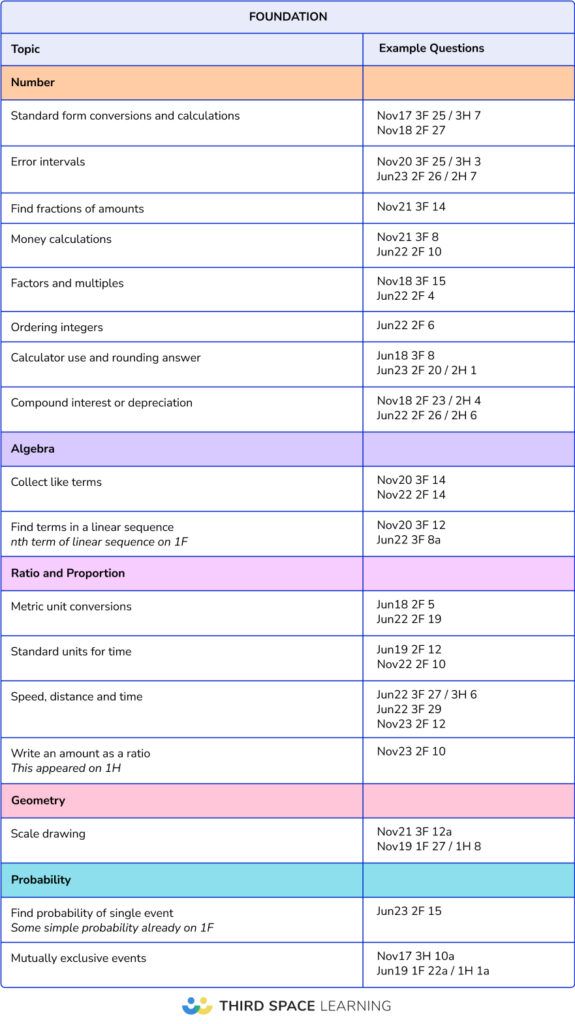What’s Next? Analysis of GCSE Maths Paper 1 Topics With Recommended Revision List For GCSE Maths Paper 2 and Paper 3 (2024)
This article was originally published on 29th May 2024.
Back for 2024, expert consultant and contributor Christine Norledge provides a detailed analysis of the GCSE maths exam Paper 1 topics from both the Foundation and Higher papers. Christine offers key recommendations on what’s likely to come up in Papers 2 and 3 and includes a hit list of recommended topics to revise next.
Last Thursday this year’s cohort of GCSE students sat their first GCSE Maths paper, which means we’re kicking off another round of live analysis blogs for the Edexcel Foundation and Higher papers. Following Paper 1 non-Calulator and Paper 2 Calculator, we look at content gaps to provide students with target areas to focus their revision for the next paper.
We’ll be here shortly after each paper with:
- A brief topic analysis
- Any unusual quirks
- Interesting questions or surprises
- Suggestions to support your students in preparing for Paper 2 and Paper 3
This article focuses on the 2024 Edexcel Foundation and Higher Paper 1, rather than AQA, OCR or IGCSE exam board. It’s also about GCSE mathematics, rather than any A Level maths.
Any recommendations in this analysis are an interpretation of GCSE Maths Paper 1. Edexcel does not endorse the analysis or recommendations. The question papers and mark schemes have not yet been formally released.
GCSE MATHS 2026: STAY UP TO DATE
Join our email list to stay up to date with the latest news, revision lists and resources for GCSE maths 2026. We’re analysing each paper during the course of the 2026 GCSEs in order to identify the key topic areas to focus on for your revision.
GCSE dates 2026
GCSE results (2026 when available)
Get ahead on revision with the GCSE maths papers analysis from 2025:
Analysis of GCSE Maths Paper 1 2025
Analysis of GCSE Maths Paper 2 2025
GCSE Maths Paper Analysis and Summary 2025
GCSE Maths Teacher Survey Results 2025
Revision focus lists for Foundation and Higher Papers 2 and 3
If you’re in a hurry, here are the revision focus lists for GCSE Maths Papers 2 and 3. These are the topics I’d direct students towards to ensure that they could do, and do well.
While we would all like to know exactly which topics will appear on Paper 2 and Paper 3, no one can make an exact prediction. The lists below are only suggestions, not exhaustive predictions of the next two papers.


Maths Paper 2 and Paper 3 Revision: GCSE Exam Questions and Worksheets
GCSE Maths Paper 2 and Paper 3 2024 Revision: Interactive topic lists, exam questions and worksheets.
Download Free Now!How best to share revision recommendations
If you are concerned about students over-interpreting revision focus lists, share these topics in a different format. You could use the Third Space Learning secondary maths resources to create a collection of practice exam questions targeting these top topics.
Free GCSE Maths Paper 2 and Paper 3 revision bundle
To make it easier, we’ve already created a free Paper 2 and Paper 3 revision bundle that includes worksheets on the hit list topics. Each worksheet includes functional and applied reasoning questions, practice questions and exam-style questions
You’ll find links to specific GCSE maths revision resources for everything you need for each of the hit list revision topics, including:
Data behind the Paper 2 and Paper 3 revision list
These revision lists are created using a combination of:
- Data analyses of all previous (June and November) series of GCSE Foundation and GCSE Higher papers
- Lists of topics that have appeared more frequently on Calculator papers
- Topics only assessed on the Calculator papers
- Topic lists from Paper 1 Foundation and Higher, sat by students on 16th May
In each series, some topics tend to appear only on one paper – it is less likely, although not impossible, that they will appear in subsequent papers.
For this series, that includes topics such as:
- Stem and leaf diagrams (Foundation)
- Finding the equation of a line from a graph (Common)
- Recurring decimals to fractions (Higher)
Some broader topics appear on two or more papers but tend to be different question types. They may change in difficulty, context or assessment objective addressed.
For example, it’s almost guaranteed that more ratio questions appear on one of the Foundation Calculator papers. However, these are unlikely to be as straightforward as writing as a ratio or simplifying a ratio.
For further details and other suggested topics, see the more detailed tables and analysis that follow.

Unlimited GCSE maths tutoring with Skye, the voice-based AI maths tutor.
Built on the same principles, pedagogy and curriculum as our traditional tutoring but with more flexibility, reach and lower cost.
Help your GCSE students achieve their target grade with Skye’s one to one maths tutoring.
Watch Skye in actionStudent reactions to Maths Paper 1
Before analysing Paper 1 in more detail, let’s quickly see what this year’s cohort made of their Paper 1 experience.
True to style, students have driven to social media to share their humour and opinions about Edexcel Paper 1



It’s safe to say that this year’s cohort, both Foundation and Higher, have found their first paper fairly challenging.
Analysis process and terminology for Maths Paper 1
This blog uses the same processes and classifications as previous exam analysis blog posts:
- Question Level Analysis Of Edexcel Maths Past Papers (Foundation) (2017-2023)
- Question Level Analysis Of Edexcel GCSE Maths Higher Past Papers (2017-2023)
This year, there are some changes to names and categories. Ratio and proportion is now its own strand as this closely aligns our analysis blog series with the GCSE Resource Library and the one-to-one GCSE Maths Revision Programme.
To summarise, I’ve analysed the Foundation and Higher paper, assigned each question a topic and strand, noted the number of marks available and given a ‘complexity’ score, which broadly aligns with the GCSE assessment objectives (see more below).
Topic classification used across all GCSE maths papers
Strand abbreviations used are as follows:

To help simplify the analysis process, high-mark problem-solving questions are classified only by their main topic.
For multi-topic questions, I’ve selected the topic required to access the majority of the marks on the question. While this omits a little detail, it makes it easier to identify trends across a larger data set.
Complexity classification used across all GCSE maths papers
The following categories help to give an idea of the complexity of each question:

This is not a ‘difficulty’ measure. For example, ‘higher grade’ topics on each tier, such as simultaneous equations on Foundation tier or trigonometric graphs on Higher tier are often examined as standard procedural.
We can see examples from this year’s Paper 1 with arithmetic sequences and fraction calculations in the crossover content (i.e. top end of Foundation), and the surds questions towards the end of the Higher paper.
The following suggestions are based on data analysis of all previous June paper series sat by students (2017-2019 and 2022-2023) – this is five series of papers.
While we now work with a fairly large data set, these are only informed recommendations. Professional judgment should guide and decide on what to do with the information.
Detailed analysis of Maths Paper 1 Foundation 2024
Unlike last year, this year’s Foundation Paper 1 felt rather mixed.
As usual, the paper started with accessible one-markers followed by a simple money problem. Additional straightforward marks were available later in the paper, such as the procedural 3-by-2-digit multiplication in Q14.
But compared to last year’s summer paper, there were some more challenging questions early on. In particular, the open-ended Q7 which invited students to draw “a suitable diagram or chart” rather than telling them which chart to draw. This feels off-trend at such an early stage in the paper.
Algebra made very little appearance in the first half of the paper other than function machines. Most of this content appeared towards the end of the paper and pitched to the top end of Foundation. Most students would likely have struggled to deal with the fractional coefficient in the inequality in Q28.
Topic allocation in Maths Paper 1 Foundation 2024

Complexity of questions in Maths Paper 1 Foundation 2024 compared to previous years

While 2024’s Paper 1 distribution is more similar to post-pandemic papers than pre-pandemic papers, we are slowly beginning to see a greater demand on some questions on the Foundation paper. Last year, nearly 60% of the paper was C1 (standard procedural), whereas this year was just over half.
The proportion of C3 questions has increased significantly. Question patterns are approaching the patterns seen in June 2018 and 2019. This could explain why students perceive this year’s paper as difficult or more challenging than the 2023 cohort.
C2 content remains fairly consistent across the summer series. Roughly 20% of the available marks on the paper were for questions involving:
- Reasoning
- Interpreting charts or tables
- Reading and synthesising information
Mark allocation for topics in Maths Paper 1 Foundation 2024 with comparison to previous years

Last year, lots of marks were awarded in the Number strand and fewer for the Ratio and Proportion strand than previously. This year’s Foundation Paper 1 appears to have a more evenly balanced mark allocation across the topics with no significant variation from normal patterns.
However, Paper 1 does have a slightly lower proportion of marks in the Ratio and Proportion and Statistics strands. Therefore, these could make more appearances in Papers 2 and 3.
I’d also expect to see more “algebra toolkit” skills on these papers, such as simplifying, collecting like terms, expanding or factorising.

Detailed analysis of Maths Paper 1 Higher 2024
Continuing the trend of Foundation Paper 1, this year’s Higher Paper 1 also felt mixed. The crossover content was fairly generous with a procedural nth term of a linear sequence as Q1 to ease students in. Additional straightforward marks were available later in the paper too. For example:
- The triple bracket expansion in Q14
- A surds questions in Q17a and b
- Simultaneous equations in Q10
However, as with Foundation, some challenging questions made an early appearance in the paper. For example, Q9 required students to understand the function of a percentage multiplier to answer correctly. Complex wording here may have stumped quite a few students.
Other complex questions saw an unusual problem for recurring decimals and Q20 required students to “work backwards” with fractional indices. Students are typically more familiar with writing the fractional power using root notation and evaluating rather than the process needed here.
Last year, Higher Paper 1 had fewer unfamiliar topic combinations than some of the previous series, and this continued in 2024. A couple of questions were asked in unusual ways, but these questions generally stayed within a single content domain.
Topic allocation in Maths Paper 1 Higher 2024

Complexity of questions in Maths Paper 1 Higher 2024 compared to previous years

2022 and 2023’s Higher Paper 1 had a very similar complexity distribution. In particular, there was a higher ratio of C1 to C3 questions than the pre-pandemic June papers. Perhaps this reflected allowances made in exam writing to account for the disruption these cohorts experienced.
While 2024’s Higher Paper 1 had slightly more marks available for multi-step problem-solving questions than the last two June series, it’s not quite back to pre-COVID distributions just yet.
C2 content is slightly down on this year’s Higher Paper 1, with around 13% of the marks available for questions involving reasoning, interpreting charts or tables, and reading and synthesising information. This isn’t a significant variation.
Mark allocation for topics in Maths Paper 1 Higher 2024 with comparison to previous years

Similar strand distribution is shown within Number, Algebra, Ratio and Proportion, and Geometry between the 2023 and 2024 Higher paper.
While fairly typical, there were slightly more Probability questions than in 2023 and slightly fewer Statistics. Generally, Statistics makes a more frequent appearance in Papers 2 and 3, where there is more space for it.
Interestingly, last year’s trend of less Ratio and Proportion content on Paper 1 continued. This could be partially due to this strand not appearing significantly in the common questions. There were quite a few more on Papers 2 and 3 last year, a similar trend could be expected for the next two 2024 papers.

What’s next? Preparing for Papers 2 and 3
As Paper 2 and 3 are both calculator papers and there is no difference between what can appear on either paper, the following suggestions apply to both Paper 2 and Paper 3.
The rest of this article looks at data across the past 7 years on both Foundation and Higher Edexcel exam papers to discuss in more detail how topics and questions have historically fallen across Papers 1, 2 and 3. This data analysis provides suggestions about what you might see in this year’s Papers 2 and 3.
Each section and chart attempts to answer a key question that will inform the next stage of your GCSE revision.
Practical revision and exam tips
If, after the first exam you think your students are still struggling with mapping out their revision effectively, then it’s also worth reviewing the guidance and resources available for them here:
Strand distribution between ‘Calculator topics’ vs ‘Non-Calculator topics’
Naturally, some topics or types of questions are more suited to either the non-calculator paper or the two calculator papers. For example, questions with marks available for accurate calculation methods, such as arithmetic, appear more frequently on the Non-Calculator paper.
However, these topics can also appear on the Calculator papers as a ‘show that’ or ‘spot the error’ question. Often, they are assumed skills for more advanced work.
Topics which don’t require a calculator but tend to appear more frequently on the two Calculator papers because there is less room for them on the Non-Calculator paper include:
- Transformations
- Constructions
- Sketching and transforming graphs
This skew is more apparent on Higher than Foundation, with the Higher Calculator papers usually containing less explicit work on Number and Proportion and more on Algebra and Shape.
Foundation Topic frequency by paper for all previous summer series

Higher Topic frequency by paper for all previous summer series

Most frequent Foundation and Higher Paper 2 and Paper 3 topics 2017-2024
The topics below have appeared on half or more of all series so far. They have also either appeared exclusively on the Calculator papers or have a significant proportion (< 80%) of appearances on the Calculator papers.
Traditionally, many of these are crossover topics and some have appeared very frequently in the previous four series. Therefore, it is unlikely that all of the topics listed below will appear in 2024. Anything relevant to 2024 Paper 1 is noted in italics.
11 common Foundation Calculator paper topics

20 common Higher Calculator paper topics

Which topics have appeared on most Calculator papers so far?
The topics below have appeared on 75% of all series of live exam papers, either on Paper 2 or Paper 3, or both. This means there’s a good probability that some of these will come up this year on either of the Calculator papers.
Anything relevant to this year’s Paper 1 is noted in italics.
This would be a good place to start when collating a “general Calculator Paper” practice booklet. There are some suggestions of questions that you could use with students so they know what sorts of things to expect.
17 topics seen on most series Foundation Maths Paper 2 and Paper 3

17 topics seen on most series Higher Maths Paper 2 and Paper 3

Which topics haven’t been seen for a while?
This selection of topics only appeared occasionally in recent series as main topics (some may be embedded in other questions).
These are ones to watch out for as they are assessed less frequently, but perhaps due a turn this year!
Some topics listed here, such as loci, are either very infrequently assessed or are demanding for that particular tier, such as quadratic equations on Foundation papers.
Topics such as these are good to prioritise once students are confident and fluent with the essentials for each paper, but they’re not an area to focus all of their revision.
9 topics less frequently featured in recent Foundation series

12 topics less frequently featured in recent Higher series

What’s next for your GCSE maths revision?
That concludes our Foundation and Higher Paper 1 analysis. The dates for the next two GCSE maths papers are:
- Paper 2 – Monday 3rd June
- Paper 3 – Monday 10th June
We’ll be back with an updated hit list and further analysis between Papers 2 and 3.
The suggested list of topics won’t change significantly between these two papers, but we’ll be able to narrow down the hit list for Paper 3 once students sit Paper 2.
Keep an eye out for a more in-depth analysis of the whole series later this academic year. We’ll be thinking about how you can use this year’s exam questions with next year’s cohort and doing some more data-crunching to look at how this series sits in the wider context of previous Edexcel Maths exam papers.
We’ll also be back in August for our Results Day blog, where we find out how students have done in Maths and across the board in the 2024 GCSE exams.
DO YOU HAVE STUDENTS WHO NEED MORE SUPPORT IN MATHS?
Skye – our AI maths tutor built by teachers – gives students personalised one-to-one lessons that address learning gaps and build confidence.
Since 2013 we’ve taught over 2 million hours of maths lessons to more than 170,000 students to help them become fluent, able mathematicians.
Explore our AI maths tutoring or find out how our GCSE maths tutoring programmes could support students in your school.







